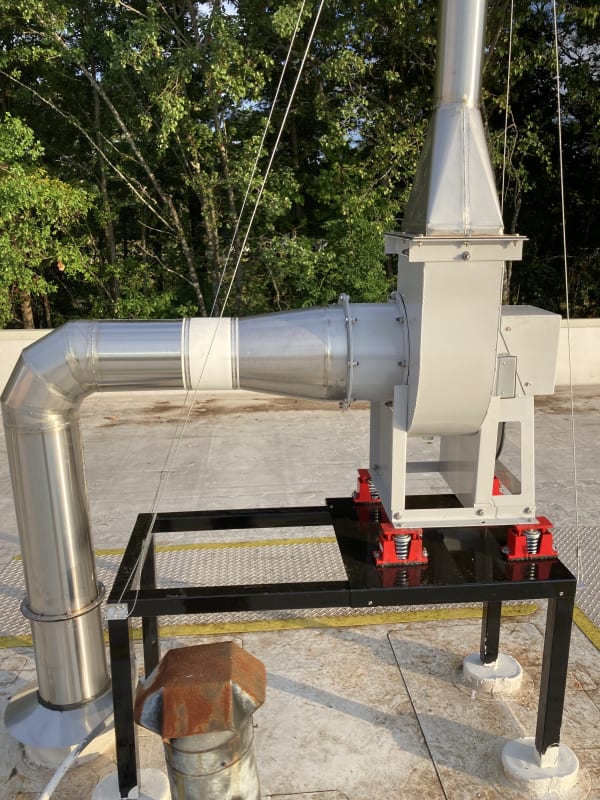IanVG
Mechanical
- Jan 21, 2022
- 76
Hello all. I'm looking into the pressure drop associated with a lab exhaust system that was just installed (see picture below). Specifically, I'm stuck now on the pressure drop that occurs the last 4-gore elbow to the exhaust fan inlet. The exhaust fan is a centrifugal blower. Having perused this online forum and the available ASHRAE books (I do not have the duct fitting database unfortunately), I'm not sure what method to use to find the total pressure drop from the elbow to the inlet of the fan. There are two approaches:
[ol 1]
[li] Use one of the ED7-* Fan Inlet loss coefficient tables provided by ASHRAE (I have ED7-1 or ED7-2). ED7-2 is the most applicable. For this approach (I think) I would not include the flexible duct connection/duct expansion joint or the round-to-round transition, as it appears to be covered by the ED7-2 pressure drop.[/li]
[li] Or, I can calculate the pressure drop piece by piece. I would use an approximation based on the roughness of the duct expansion joint (neoprene) and table SD4-1 for the loss coefficient for the round-to-round transition. [/li]
[/ol]
Both of these approaches seem unsatisfactory because, Approach 1 does not account for the duct expansion joint and the round-to-round transition while Approach 2 does not account for the Fan System Effect Coefficient. I believe there will be a Fan System Effect Coefficient because the 5*d (d=diameter of duct=12"Ø in this case) length requirement (by requirement I mean rule of thumb in the office, because I have also seen that 3*d may be sufficient in other cases-this may depend on the type of elbow) for the straight duct to develop laminar flow after the elbow was not met.
Does anyone have any guidance or advice on this issue?

[ol 1]
[li] Use one of the ED7-* Fan Inlet loss coefficient tables provided by ASHRAE (I have ED7-1 or ED7-2). ED7-2 is the most applicable. For this approach (I think) I would not include the flexible duct connection/duct expansion joint or the round-to-round transition, as it appears to be covered by the ED7-2 pressure drop.[/li]
[li] Or, I can calculate the pressure drop piece by piece. I would use an approximation based on the roughness of the duct expansion joint (neoprene) and table SD4-1 for the loss coefficient for the round-to-round transition. [/li]
[/ol]
Both of these approaches seem unsatisfactory because, Approach 1 does not account for the duct expansion joint and the round-to-round transition while Approach 2 does not account for the Fan System Effect Coefficient. I believe there will be a Fan System Effect Coefficient because the 5*d (d=diameter of duct=12"Ø in this case) length requirement (by requirement I mean rule of thumb in the office, because I have also seen that 3*d may be sufficient in other cases-this may depend on the type of elbow) for the straight duct to develop laminar flow after the elbow was not met.
Does anyone have any guidance or advice on this issue?

